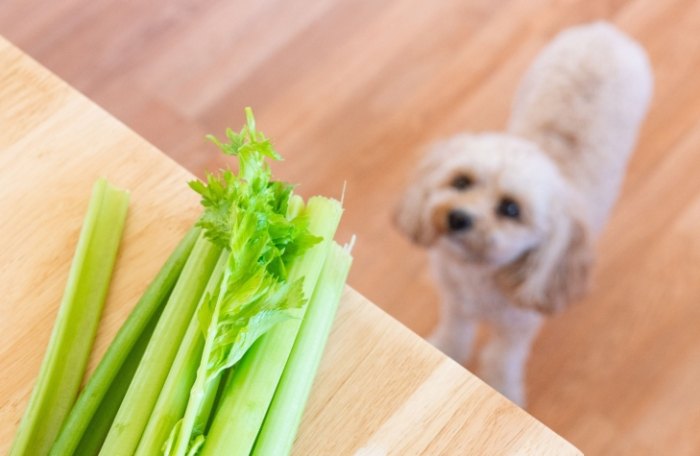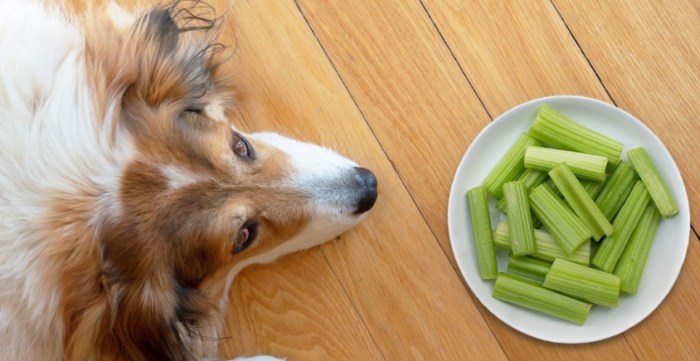Advertisements
Can Dogs Have Raw Celery? Benefits, Health Issues, Safe Feeding & Ideal Amounts
Can dogs have raw celery? Discover the benefits of eating celery for dogs, potential health issues with eating celery for dogs, and learn how to practice feeding celery to dogs safely. Plus, find out how much celery can dogs eat for a healthy treat!
Table of contents
As a fellow pet owner who's dealt with more than my fair share of curious canine snouts sniffing around the kitchen, I know how tempting it is to share bits of our food with our furry pals. But when it comes to veggies like celery, it's not always a simple yes or no—there's a whole world of dos and don'ts. In this guide, I'm breaking down everything you need to know, based on my own experiences with my two rescue mutts, Bella and Max. They're always begging for scraps, so I've had to learn the hard way about what's safe and what's not. Stick with me, and we'll cover it all step by step, without any fluff.
Can Dogs Have Celery
Alright, let's tackle the big question head-on: can dogs have celery? Spoiler alert—yes, they totally can, but it's not like tossing them a bone and calling it a day. There's more to it than you might think.
What's the Deal with Celery and Dogs?
When I first started researching can dogs have celery, I was surprised to find that it's actually okay in moderation. Celery isn't toxic to dogs like chocolate or grapes—phew! That means if your pup snags a bite off the floor, you probably don't need to panic. But here's the thing: dogs don't digest veggies the same way we do. Their tummies are built for meat, so veggies like celery should be occasional treats, not staples. From my chats with vets and my own trial-and-error with Bella (she loves crunching on celery sticks during movie nights), it's clear that while can dogs have celery is a yes, it's not a free pass to feed it willy-nilly. Always watch for how your dog reacts, because every pooch is different—some might gobble it up, others sniff and walk away.
Why Celery Isn't a Dog Food Staple
Now, just because can dogs have celery is a green light doesn't mean it's a superfood replacement. Celery is mostly water and fiber, which can be great for hydration but not so hot for nutrients. Think of it like a low-cal snack: it won't pack on pounds, but it won't give your dog the protein or fats they crave. I remember when Max was a puppy; I tried sneaking celery into his kibble to help with weight management. It worked okay, but I learned quickly that relying on it too much led to him getting bored—dogs need variety, just like us! So, while can dogs have celery is a fact, it's best as an add-on, not the main event. Keep it balanced with their regular diet, and you'll avoid any nutritional gaps.
Real-Life Reactions from My Pack
Here's the fun part: how do dogs actually respond to celery? Well, in my house, it's a mixed bag. Bella acts like it's the best thing since peanut butter—she wags her tail and crunches away. Max, on the other hand, gives it a few cautious licks before losing interest. This teaches me that can dogs have celery depends on your dog's personality. Some might love the texture (it's crunchy and fun to chew), while others find it bland. To make it more appealing, I often dip celery in a smear of dog-safe peanut butter—instant hit! But always start small; introduce celery slowly to see if your dog enjoys it. If they do, great! If not, no sweat—there are plenty of other safe veggies out there. Just remember, even though can dogs have celery is true, it's not a must-have in every bowl.
Potential Health Issues with Eating Celery for Dogs
Okay, let's get real—celery isn't all rainbows and unicorns for our pups. There are some legit Potential Health Issues with Eating Celery for Dogs that you need to know about. Trust me, I've seen Bella choke on a big piece once, and it scared the heck out of me. That's why I'm sharing this section to help you steer clear of trouble.
Choking Hazards: A Scary Reality
One of the biggest Potential Health Issues with Eating Celery for Dogs is the risk of choking. Celery stalks are long, stringy, and tough—kind of like nature's dental floss, but not in a good way for dogs. If your dog gulps down a big chunk without chewing properly (and let's face it, many dogs are vacuum cleaners), it can get stuck in their throat. I witnessed this with Max when he snatched a whole celery stick off the counter; he started coughing and gagging until I intervened. To avoid this nightmare, always cut celery into small, bite-sized pieces—no longer than an inch. Better yet, peel off the strings to make it softer. This simple step dramatically reduces Potential Health Issues with Eating Celery for Dogs, turning a risky snack into a safe one. Don't underestimate it; choking is no joke and can lead to vet emergencies.
Digestive Upsets: Tummy Troubles Galore
Another key aspect of Potential Health Issues with Eating Celery for Dogs is digestive distress. Celery is packed with fiber, which sounds healthy, but too much can cause gas, bloating, or even diarrhea. When I fed Bella too much celery as a treat last summer, she spent the next day with an upset stomach—lots of whining and extra potty breaks. Not fun for anyone! This happens because dogs aren't designed to handle high-fiber veggies like we are; their guts can rebel, leading to discomfort. To minimize Potential Health Issues with Eating Celery for Dogs, introduce it gradually and in small amounts. If your dog has a sensitive stomach or existing issues like IBS, skip celery altogether. I learned this lesson hard: moderation is key. Overdoing it can turn a healthy snack into a messy disaster.
Allergic Reactions and Toxins
Let's not forget about allergies—yes, dogs can have them too! Potential Health Issues with Eating Celery for Dogs include allergic reactions, which might show up as itching, swelling, or hives. While celery isn't a common allergen like wheat or dairy, it's still possible. With Max, I noticed some mild itching after his first celery bite, so I backed off and consulted our vet. Turns out, he's fine with it now, but it taught me to always monitor for signs. Also, beware of pesticides or chemicals on store-bought celery; they can cause toxicity. Washing thoroughly helps, but organic is best. Overall, Potential Health Issues with Eating Celery for Dogs are manageable if you're cautious, but ignoring them can lead to vet bills. So, keep an eye out—better safe than sorry!
Benefits of Eating Celery for Dogs
Now for the bright side: Benefits of Eating Celery for Dogs are actually pretty awesome when done right. I mean, who wouldn't want their dog to enjoy a low-cal snack that freshens breath? Bella sure does, and it's become a staple in our treat rotation.
Hydration and Weight Management Perks
First up in the Benefits of Eating Celery for Dogs is hydration. Celery is about 95% water, making it perfect for hot days or active pups. When we're out hiking, I pack celery sticks for Bella instead of sugary treats—it keeps her hydrated without the crash. Plus, it's super low in calories (just 10 calories per stalk!), which helps with weight control. Max used to be a bit chunky, so I swapped high-fat snacks for celery. Over time, he slimmed down, and his energy levels soared. That's a huge win in the Benefits of Eating Celery for Dogs column—think of it as nature's diet aid. Just feed it fresh and raw for max effect, and your dog will thank you with wagging tails!
Vitamins and Minerals Boost
Another gem in the Benefits of Eating Celery for Dogs is its nutrient profile. Celery is loaded with vitamins A, C, and K, plus minerals like potassium and folate. These support everything from immune health to bone strength. I noticed Bella's coat got shinier after adding celery to her diet—vitamin A for the win! But don't overhype it; celery isn't a multivitamin replacement, just a nice bonus. For older dogs, the antioxidants can help fight inflammation. I started giving Max celery when he showed signs of joint stiffness, and it seemed to ease things a bit. So, while Benefits of Eating Celery for Dogs are real, they're supplemental. Pair it with a balanced diet for best results, and watch your pup thrive.
Dental Health and Fresh Breath
Here's a fun one: celery can be a natural toothbrush! That's right, Benefits of Eating Celery for Dogs include dental perks. The crunchy texture helps scrape away plaque and tartar, freshening breath in the process. Bella used to have stinky dog breath, but after regular celery treats, it's way better. I even call it her "veggie floss." To boost this, freeze celery sticks for an extra-crunchy chew—it satisfies their urge to gnaw and cleans teeth without additives. Just be mindful of the strings, as they can cause choking. Overall, this is a standout in the Benefits of Eating Celery for Dogs, making it a smart addition to oral care routines. Why spend on expensive dental chews when nature provides?
Feeding Celery to Dogs Safely
Alright, so we've covered the good and the bad—now let's talk about Feeding Celery to Dogs Safely. This is where my mishaps come in handy. After that choking scare with Max, I've become a pro at prepping celery without risks.
Prep Steps for Risk-Free Treats
To ace Feeding Celery to Dogs Safely, start with prep work. Always wash celery thoroughly to remove dirt or pesticides—I use a vinegar soak for extra cleanliness. Then, cut it into small pieces: think pea-sized for small dogs or inch-long sticks for big ones. Remove those pesky strings; they're the main culprits for choking. Personally, I peel the stalks like a carrot to make it softer. Cooked celery is even safer for Feeding Celery to Dogs Safely—light steaming softens it up without losing nutrients. I do this for Max since he has dental issues. Avoid seasonings like salt or garlic—they're toxic! Stick to plain, unadorned celery. This simple routine turns a potential hazard into a healthy snack.
Serving Ideas That Dogs Love
Next up in Feeding Celery to Dogs Safely is making it appealing. Dogs can be picky, so jazz it up! I mix celery with other dog-safe foods: stuff it with peanut butter or blend it into their kibble. For hot days, freeze celery chunks in water for a hydrating "pupsicle." Another trick: combine it with carrots or apples for variety. When I serve it this way, Bella gobbles it down—no fuss. But always supervise eating to catch any issues early. Feeding Celery to Dogs Safely also means timing it right; offer it as a treat, not a meal replacement. I aim for post-walk rewards to avoid overexcitement. With these tweaks, celery becomes a hit without the hassle.
Red Flags to Watch For
Lastly, Feeding Celery to Dogs Safely involves knowing when to stop. If your dog shows signs like vomiting, diarrhea, or lethargy, ditch the celery and call your vet. Bella once had a mild reaction on a humid day—it turned out celery exacerbated her heat sensitivity. Now, I skip it during extreme weather. Also, avoid celery for puppies, seniors, or dogs with health issues unless your vet approves. I learned that Max shouldn't have it when he's on certain meds. Overall, Feeding Celery to Dogs Safely is about listening to your dog and adjusting. It's a small effort for big peace of mind.
How Much Celery Can Dogs Eat?
Now, the million-dollar question: How Much Celery Can Dogs Eat? Get this wrong, and you're in for cleanup duty. I've fine-tuned this with Bella and Max over the years—let's dive in.
Guidelines Based on Size and Breed
First off, How Much Celery Can Dogs Eat? depends on your dog's size. As a rule of thumb, small dogs (under 20 lbs) should have no more than a tablespoon per serving, medium dogs (20-50 lbs) up to a quarter cup, and large breeds (over 50 lbs) about half a cup max. For Bella (a 30-lb terrier mix), I stick to two or three small pieces a day. Big dogs like Max (a 70-lb lab) can handle a bit more, but I cap it at a few stalks weekly. Overfeeding leads to digestive chaos—trust me, I learned from a messy cleanup! So, How Much Celery Can Dogs Eat? isn't one-size-fits-all; adjust for your pup's needs.
Frequency and Timing Tips
Next, How Much Celery Can Dogs Eat? ties into how often you feed it. Aim for no more than 10% of their daily calories from treats—that includes celery. For most dogs, that's once or twice a week. I time it for active moments, like after walks, to aid digestion. Never feed it on an empty stomach; pair it with a meal to avoid tummy upsets. Monitoring is key: if your dog handles it well, you can gradually increase, but always start slow. With Max, I began with tiny bits and built up. This approach to How Much Celery Can Dogs Eat? prevents overdoing it and keeps things enjoyable.
Adjusting for Health and Lifestyle
Finally, How Much Celery Can Dogs Eat? should factor in your dog's health. Overweight dogs? Use celery as a low-cal filler—it helped Max shed pounds. Active dogs might need more hydration. But if your dog has kidney issues or diabetes, consult a vet first; celery's potassium and sugars can affect conditions. I check in with our vet annually to tweak amounts. Also, consider other veggies in their diet to avoid imbalance. Overall, How Much Celery Can Dogs Eat? is about balance—moderation ensures they reap benefits without risks.
Frequently Asked Questions
Here's a quick Q&A based on questions I get all the time from other dog parents. These cover common concerns and build on what we've discussed.
How do dogs react to celery?
Dogs react differently—some love the crunch (like Bella), others ignore it. Reactions depend on taste preferences and texture. If your dog enjoys it, great! If not, try pairing it with something tasty. Always watch for choking or allergies during their first try.
Is celery a laxative for dogs?
Yes, in large amounts, celery's high fiber can act as a laxative, causing diarrhea. That's why moderation is crucial. Feed small portions to avoid digestive issues. If you notice loose stools, cut back on celery.
Can dogs have raw celery?
Absolutely! Raw celery is safe and retains more nutrients. Just cut it small to prevent choking. I feed raw celery to Bella all the time—she loves the fresh crunch. Cooked is fine too, but raw is simpler.
Can Dogs have celery raw
Same as above—yes, dogs can have celery raw. It's hydrating and crunchy, but prep it safely. Remove strings and chop finely. Max handles raw celery well now, with no problems.
Is cooked celery good for dogs
Cooked celery is softer and easier to digest, making it great for older dogs or those with dental issues. Steam it lightly without seasonings. I cook it for Max sometimes—it's a nice change from raw.
Can dogs have celery juice
Generally, avoid celery juice—it's concentrated and lacks fiber, which can cause stomach upset. Stick to whole celery for safety. If you insist, dilute it heavily and consult your vet.
Celery for dogs teeth
Yes, celery acts as a natural toothbrush by scraping plaque. Its crunchiness helps clean teeth and freshen breath. I use it as part of Bella's dental routine—it's cheaper than store-bought chews.
What vegetables can't dogs eat?
Avoid onions, garlic, grapes, and avocados—they're toxic. Stick to safe ones like carrots or green beans. I always double-check veggies before sharing to keep Bella and Max healthy.
Leave a Message